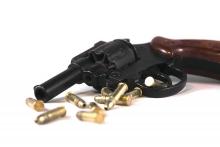according to the findings of a cross-sectional analysis.
“For homes with children and guns, the odds are roughly 2 to 1 that firearms are not stored in accordance with recommendations promulgated by the [American Academy of Pediatrics], regardless of whether children in the home have a history of self-harm risk factors” wrote John Scott of Northeastern University, Boston, and his colleagues. “Given the prevalence of household firearms in the United States, our findings suggest that millions of U.S. children are placed at substantially higher risk of fatal firearm injury, especially suicide, than would be the case were parents to follow guidelines first put forward by the AAP.”
The information from the study was collected from a cross-sectional analysis of a nationally representative, online survey of U.S. adults from March to April of 2015. Of the 7,318 adults invited to participate, 3,949 completed the survey (a 55% response rate). The survey was conducted by the firm Growth for Knowledge to learn about firearm ownership, storage practices, and firearm use in adults. The adults selected for participation were drawn from Growth for Knowledge’s Knowledge Panel.
Survey participants were asked a variety of questions pertaining to gun ownership, such as: “Do you or does anyone else you live with currently own any type of gun?”and “Do you personally own a gun?” After determining gun ownership and style of gun (long rifle vs. handgun), survey respondents were questioned about how they stored their guns: Were they kept locked, unloaded, and away from ammo? Or were they stored unlocked and loaded?
After ascertaining information about firearm possession and storage practices, the researchers asked respondents if they were caregivers for children under the age of 18 and whether or not these children had any of the following medical conditions determined to be self-harm risk factors: depression, mental health conditions other than depression, or ADHD.
The researchers found that firearms were present in 42% of households, regardless of whether a child had a history of self harm risk factors (44%). Only one-third of household firearms were securely locked and unloaded. The proportion of parents who store at least one gun loaded and unlocked is only slightly lower among parents with children who have self-harm risk factors, compared with parents with children who have no history of self-harm risk (12% vs. 20%, respectively). Parents whose children have a history of depression, other mental health issues, and ADHD are also not significantly more likely to store all household firearms locked, compared with those whose children do not have such a history (62% vs. 52%, respectively).
Online surveys such as the one in this study rely on data that are reported by non-health experts, so the potential for a parent to misclassify their child’s mental or behavioral health issues is a distinct possibility. Like most self-reported data, social desirability bias may play a role in determining how parents responded to the survey regarding their children’s health.
While storage practices do not seem to change based on child self harm risk factors, the American Academy of Pediatrics has issued recommendations that may help convince some parents.
“Guidelines intended to reduce firearm injury to children, first issued by the American Academy of Pediatrics (AAP) in 1992, assert that whereas the safest home for a child is one without firearms, risk can be reduced substantially, although not eliminated, by storing all household firearms locked, unloaded, and separate from ammunition” Mr. Scott and his associates wrote. The study was published in Pediatrics.
The authors indicated they had no relevant financial disclosures. The study was supported in part by grants from Fund for a Safer Future, the Joyce Foundation, and the U.S. Department of Veteran Affairs.
SOURCE: Scott J et al. Pediatrics. 2018 February 26. doi: 10.1542/peds.2017-2600.


